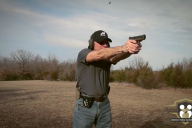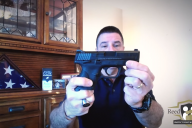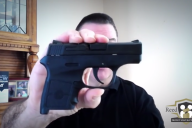Kel-Tec P-3AT Review by David C. Reed
TRANSCRIPT
Hello again, I’m David Reed with Reed and Ward, the makers of CCW Guardian, the premier smartphone app for CCW permit holders. This is a review of the Kel-Tec 3AT in 380 ACP. Now, I’m going to open her up, take a look, weapon is safe. I’m going to hold it like so with my hands, so I can visually and physically inspect the chamber. The weapon is clear and safe. There’s no one behind the camera. There’s no ammo in the area. We have a safe training area.
All right, let’s take a look at the Kel-Tec 3AT. Get it? 380? The model number of this weapon 3AT looks like a strong password for your computer, but this is to separate it from the Kel-Tec 32 of which it’s almost identical to except in caliber. The weapon is 5.2 inches long, 3.5 inches high. Weighs about 8.3 ounces empty, which means it is incredibly lightweight. Looking here at the starboard side. I’ll tell you it has a 2.75 inch barrel and it is kind of a hammer fired weapon. Some people have referred to these as a striker-fire. I don’t think that’s correct. You do have to cock the weapon, and then watch the rear right here, you’ll see there is, bang, a hammer. You can’t stage the hammer, but, nor do you get second strike capability, like a striker-fire, you have to recheck it and take that trigger all the way off, more like a hammer fire, and then come back. So, mechanically it’s a hammer fired weapon, but it cocks via a striker-fired type mechanism. So, it’s kind of unique.
These Kel-Tecs are unique to begin with. This is arguably the pistol that, back in nearly 2000s, started the stampede of CCW permit holders buying small, lightweight, compact, semiautomatic pistols to carry. A lot of police officers I know bought them as a backup to their service gun because they were inexpensive, reasonably reliable, and fairly accurate at close distances, which is the mission of this pistol.
This is not a match grade weapon. It’s not designed to shoot targets and go out and plink with. This is designed to be carried often and shot, well, only as much as you need to. It has, you know, pretty good rough stifling on the side of the grip, which means that you should be able to get a good purchase even if your hands are wet or cold.
A lot of people I know, when out and put these belt clips on, like you see on this one so that you could wear it inside of a pocket or inside of your pants. Even with your shirt tucked in the gun practically disappeared. This is a true pocket pistol.
Now, some of the things that I don’t like, and let me roll it over to the top and you can see it has a 0.77 inch wide slide. It’s the second slimmest 380 pocket pistol that I’ve evaluated. It is slightly slimmer than a Ruger LCP, which seems to share a lot of the same features with the Kel-Tec and it is considerably thinner than say, a Glock 42 380, but not as thin as a Smith & Wesson M&P Bodyguard. All the weapons that are in this general category. The reason I rolled it over right there again, to let you look is, if you take a look at the sites you can see it really doesn’t have any. This is not designed as an aimed fire, you know, hobbyist gun. This is a gun designed to fit slick into your pocket so it’s not going to hang up on anything. You know, you put this weapon into a pocket holster, wear it in your pocket and it practically disappears. The gun itself is about the same size as a cell phone and it pays a penalty in that. Do to it’s light weight and it’s compact and lack of sites, it’s not the most overall accurate pistol I’ve ever fired in my life and I’ll tell you it’s a little snappy in the hand. Even with 380 caliber, but I’ll show you.
Now take a look at those sites. Again, you can see it’s just a groove cut in the rear of the slide and a little bump milled into the slide on the front right there. So as you can see this gun really doesn’t have any sites. They’re not adjustable at all. That front sight looks like maybe it can be pulled off and something could be replaced, but why? This is a very lightweight, compact pistol that is designed with or without a holster, to go anywhere and everywhere and it’s the gun that you’re going to have with you when you’re not going armed, so to speak.
It is a 380. The 32 version that came out was very popular, but 380 is really the entry level of a defensive caliber and I tell you, when I carry a 380 pistol, I don’t consider myself well armed at all. In fact, it’s only in extreme summertime, you know, t-shirt and shorts. Generally I can even carry a small compact 9 mm, but this is the gun that, if you go out jogging, if you go out walking, this is an easy to carry, small compact, lightweight weapon. That’s the niche that it fills and I don’t think you should try to put into any other category. Even with the magazine inserted, the gun does not lock to the rear. So, that’s one of those things that you’re just going to have to get used to is placing your hand, like so, on the back of the slide and making a lever and cocking the weapon back so that you can visually physically inspect the chamber. You could pinch-pull it back and you can look into it, then you can lock it like this and you can see into the weapon.
So some people, a lot of inexperienced people, have purchased this weapon and I will tell you, I actually think of this more as a weapon for someone who’s had some training as opposed to, you know, some of the other guns in the caliber where you can lock the slide open and check and they have various safety mechanisms and whatnot. This weapon has all the safeties on the inside. It is a safe, small weapon, but there are no manual safeties at all. So if you place your finger on the trigger and pull or if an inanimate object, like an ink pen or pencil or your keys, get into that trigger guard and you pull on it the wrong way, the weapon will discharge. So if you carry it in a pocket, which is what it kind of was designed for, use a pocket holster.
All right. In the Reed Ergo Power Ratio tool, you have to be careful how you evaluate these little pocket. Don’t compare them to say, a Glock 23 or something. It’s not a fair comparison. They have two different missions. So for purposes here, the weapon is a 380, so it gets a two out of five in section A of the Reed Ergo Power Ratio tool. In the REPR, section B, overall capacity, it’s 6+1. So you get three points out of five. So, this weapon, in categories A and B combined, gets five points before we take it outside and shoot section C and D.
Overall, it’s very slim, very compact, very light weight. There are no sharp edges. Nothing on this weapon is fully melted so that I feel confident that I can carry this weapon in it’s not going to hang up on clothing during the draw or anything like that. Well, let’s take it outside and see how it shoots.
Okay were outside with the Kel-Tec P-3AT in 380 ACP. We’re going to shoot section C and D of the Reed Ergo Power Ratio tool. Now section C measures recoil management and with this small of a gun, it might be an issue, but offset that with the fact that it’s a 380 ACP. Recoils shouldn’t be that big of an issue.
So the goal is to put two shots on a 3 1/2 by 5 inch index card at 7 yards within two seconds. If it takes more rounds or say three seconds, well then you go down to four points. If it takes you more rounds or more time then you subtract accordingly, but if I can get two rounds in two seconds at 7 yards on that 3.5 x 5″ target I get five points in section C.
Section D, practical accuracy. Again, same target same distance, but I fired five shots in not more than 15 seconds and not more than three second splits. The idea here is, how well can I manage the weapon, control the trigger and see the sights. With this weapon we’ll have to see.
So eyes and ears the line is hot. We’ll shoot section C first. I’ll start from the ready. On the beat. Wow, squeezed those in in 1.92 seconds. I probably could have shot little bit faster, but I had a pretty big group. You’ll see that in a minute. Now let me reload. I’ll reset the timer and will shoot section D. 5 shots and 15 seconds with not more than three second splits. Okay again range is still hot from the ready. On the beat. There you go. Well my splits were two seconds apart which is fine and it took me 10 seconds 10.4 seconds to get all five shots on that paper. Let’s go take a look at the targets and you’ll see why I kind of shot this one a little more slowly.
You know, there is nothing like missing the target in front of all your buddies. Stifle yourself over there. All right, here we go with the Kel-Tec P-3AT.
I threw a shot out in section C, so being fair and honest about it but there it is. I could have reshot the video or something, but I didn’t want to do that. I wanted to show you what happened. 7 yards tinted glasses I thought that shot was on I thought another shot was right there. It just looked closer, but when I come up here and look at it. What’s sad is when you run this test, and I knew this was invented it, you can keep shooting if you know the shot is off until you get two shots on and then total the amount of time and configure the points accordingly. What I did, is I thought I had them both on and stopped shooting. Okay history’s been made out here. I missed. In any event I gotta score this, to be fair I scored four points, but when you run this test I can run it again if I wanted to carry the 380. You know, if you make a mistake like that you just keep shooting until you get two on and then you just look at the time. Either way I made it in two seconds, but I didn’t get two shots on so four points right here. Over here again got a shot off, I had one shot and this isn’t two shots, it hit a staple from behind then blew back. So, I’ve got 1, 2, 3, 4, 5. Again, one shot dropped out.
Now in section D, practical accuracy, you only get five shots. You can’t keep reshooting like you can over here. So here four and four. That gets me eight points to the Kel-Tec P-3AT. Add that to the five you got in there and it still gets 13 points.
Now, to put this in perspective, there’s not really any kind of site on the weapon, you’re basically putting a little bumpy thing in the middle of the target and controlling the triggers, the best thing you can do for accuracy. But if you look, this is a B 27 target. All of the shots would still be right here. So you assess, that’s the purpose of the REPR tool, you assess whether or not this is adequate for you to carry that weapon and ammo with your skill set in a defensive carry situation.
I would say that given that this is a pocket pistol with no real sites to it, I think it did just fine, so the Kel-Tec to be actually surpassed my expectations. I kind of thought this was the not going to do very well, but I have to in my mind put the Kel-Tec now in a different category. It got 13 points that’s the same as a high-quality 38 special snobby that I shoot. Okay so the Kel-Tec did its job. Hats off.
Now one other thing I want to take a second and thank Jesse and the gang at ammoanimal.com. They’re the ones who provide the ammunition to Reed and Ward to do all of these video shoots and reviews and things like that. So thank you to ammoanimal.com feed your ammo animal.
The last thing I’m going to do, is I’m going to find my smart phone, here it is. Last thing I’m going to do of course is I’m going to pull up CCW Guardian App on my smartphone right there.
And I’m going to document this training. I’m going to photograph this target including my mistake right here because the more honest you are if this is ever used as evidence in a court of law well the more honest you are the more a jury can identify with you because everybody makes mistakes like this. But look at that the shots are there my training documents that and I document my training fairly and realistically. I think that’s important. Police and military have training records to back them up in case of a use of force lawsuit. You need the same thing. You need CCWGuardian.com on your side to help you document your training as a hedge against allegations of recklessness or negligence.
Anyway I’m David Reed with Reed and Ward and that’s a wrap. Thanks for watching.








6 Comments
I have one question about the Kel-tec 380. Once I load a round in the chamber, is the hammer in a cocked position to fire or does it only fire when the trigger is pulled and the hammer comes back and strikes the shell. In other words, once a round is loaded in the chamber, is the hammer in a resting safety position and not cocked, like a double action pistol. Until I get my answer, I just load my magazine and don’t pull the slide back to load a round in the chamber until I’m ready to fire it.
Thank you for answering my question in advance.
Jim Madre
Good question. I have carried mine chamber loaded. It is essentially pre-staged. So more like a DAO pistol. Check out their webpage for more detail.
I would like your thoughts on the Diamond Back 9mm. The reason I ask is that I have heard that Kel Tec and Diamond Back are produce by the same company. My first weapon was a Kel Tec 380 and I didn’t like it.
Thank You for your response.
Sport but I have no experience working with a Diamondback. What is your assessment of the handling/ function of those firearms?
I meant “Sorry”
I use my range time the way i see actual real live security videos. i quickly pick up my kel tec P32 from the range table, cock it (thats my carry mode) point (not aim) and quickly JERK the trigger twice. I’ve not seen one fellow brother carrier, or store clerk shoot at an attacker any other way in dozens of security videos.